In May 1498, Vasco Da Gama, accompanied by a Gujarati pilot named Abdul Majid, arrived in Calicut with three ships. Calicut had the status of a key trading hub and the Hindu ruler, the Zamorin, welcomed them. Vasco Da Gama’s return in 1501 saw a complete rupture with the Zamorin, as he sought to replace Arab merchants with Portuguese. He established a trading post in Cannanore, and over time, Calicut, Cannanore, and Cochin became key Portuguese trade centers, and gradually fortified under the pretext of protecting their commercial interests.
- Quest for Dominance: The Portuguese aimed to monopolize the trade, particularly in spices, by excluding competitors, especially Arabs.
- Merits of Direct Trade with India: Vasco Da Gama stayed for three months, returning to Portugal with a lucrative cargo, demonstrating the value of direct access to pepper trade.
- Setting-up of Factory and Trading Post: In 1500, Pedro Alvarez Cabral arrived in Calicut to negotiate for spices and establish a factory in Calicut.
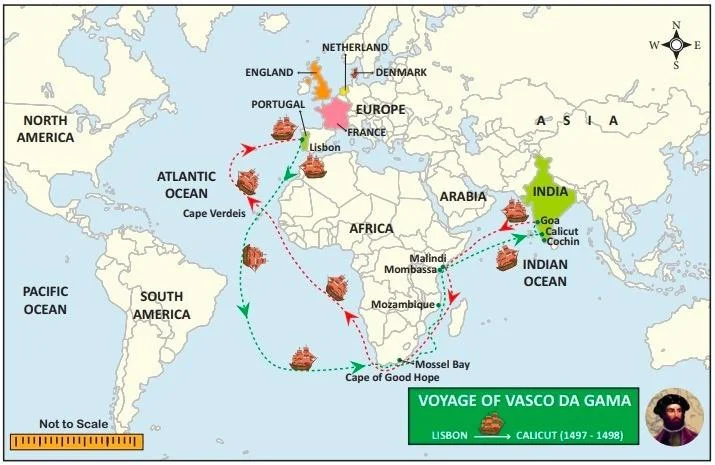
Enroll now for UPSC Online Course
Portuguese Trades
|
Notable Governors
Francisco De Almeida
In 1505, the King of Portugal appointed Francisco De Almeida as governor of India, granting him substantial resources to safeguard Portuguese interests.
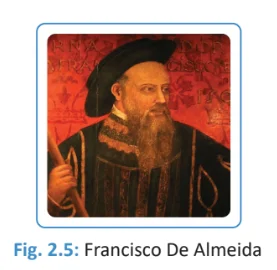
- Mandates: Almeida’s mandate was to strengthen the Portuguese presence in India and disrupt Muslim trade by capturing key locations like Aden, Ormuz, and Malacca.
- He was also instructed to construct fortresses in strategic places.
- Conflicts: Almeida faced resistance not only from the Zamorin but also from the Sultan of Egypt.
- Encouraged by Venetian merchants, as their trade was at risk due to Portuguese interference, the Egyptians assembled a fleet in the Red Sea to oppose the Portuguese advance.
- In 1507, the Portuguese squadron suffered a defeat in a naval battle off Diu against the combined Egyptian and Gujarat navies, resulting in the death of Almeida’s son. The following year, Almeida sought vengeance and decisively defeated the two navies.
- Towards Blue Water Policy: Almeida’s ambitious goal was to establish Portuguese mastery over the Indian Ocean, a strategy known as the Blue Water Policy, implemented through the cartaze system.
| Views
As long as you may be powerful at sea you will hold India as yours; and if you do not possess this power, little will avail you a fortress on shore. —Francisco De Almeida |
Alfonso de Albuquerque
Albuquerque, who succeeded Almeida as the Portuguese governor in India, played a pivotal role in establishing Portuguese dominance in the East. He strategically controlled the Indian Ocean by establishing bases at key entrances, which were East Africa, the Red Sea, Ormuz, Malabar, and Malacca.
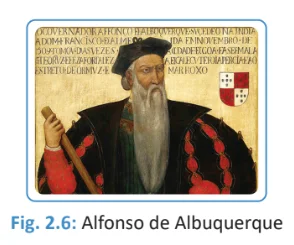
- Permit System for Ships: Under his leadership, the Portuguese implemented a permit system for ships and gained control over major ship-building centers in the region.
- First European Possession: In 1510, Albuquerque acquired Goa from the Sultan of Bijapur, marking the first European possession of Indian territory since Alexander the Great’s time. Notably, he abolished the practice of sati during his rule.
- Attempt at Blending with Local Populace: Intermarriage between Portuguese men and Indian women was promoted to establish a permanent Portuguese presence in India.
- They established themselves as landlords in villages, constructing infrastructure, roads, and irrigation systems, introducing new crops like tobacco, red chilies, and cashew nuts, and cultivating coconut groves for coir rigging and cordage
- In urban centers like Goa and Cochin, they thrived as artisans, craftsmen, and traders. Many of these Portuguese settlers came to consider their new homes, rather than Portugal, as their true homeland.
- Persecution of Muslims: Albuquerque pursued policies that led to the bitter persecution of Muslims to eliminate their commercial influence in the East, while also strengthening Goa’s fortifications.
Nino da Cunha
- Nino da Cunha became governor of Portuguese interests in India in 1529 and moved the government’s base to Goa in 1530.
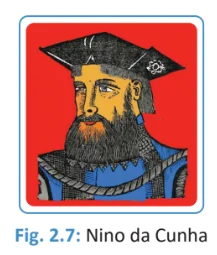
- In 1534, Bahadur Shah of Gujarat sought Portuguese aid against Mughal Emperor Humayun, ceding them Bassein and promising a base in Diu.
- Relations soured when Humayun withdrew from Gujarat in 1536, leading to conflict in the town. Bahadur Shah’s proposal of a partition wall was opposed by the Portuguese, resulting in negotiations where the ruler of Gujarat was invited onto a Portuguese ship and killed in 1537.
- Da Cunha also tried to expand Portuguese influence in Bengal, establishing Hooghly as a key center.
Portuguese Administrative Structure Political Power of Portuguese in India
Regions of Influence
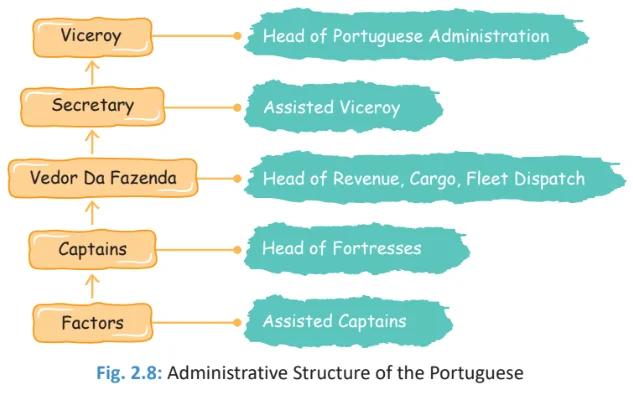
The Portuguese hold in India is often underestimated. The Estado Português da Índia (State of Portuguese India) was a significant force in Indian history.
- Within fifty years of Vasco da Gama’s arrival, they controlled many coastal regions, including about sixty miles around Goa.
- Along the west coast from Mumbai to Daman and Diu, they commanded key ports and numerous towns.
- In the south, they established seaport fortresses and trading posts in places like Mangalore, Cannanore, Cochin, and Calicut.
- The Portuguese also established military posts and settlements on the east coast at San Thome (Chennai, Tamil Nadu) and Nagapattinam (in Tamil Nadu).
- By the late sixteenth century, a prosperous settlement had developed in Hooghly, West Bengal.
Diplomacy
They engaged in diplomatic relations with major Indian kingdoms, signing treaties with Deccan sultans in 1570, regularly renewed. The Portuguese played a role in power struggles between various Indian factions between Vijayanagar and Deccan sultan, between Deccanis and Mughal, and between Mughal and Marathas over the centuries.
Interestingly, they were both the first and last Europeans in India, leaving only in 1961 when the Government of India reclaimed Goa, Daman, and Diu.
Religious Policy of the Portuguese
- Religious Tensions: The Arabs and the Moors (Muslim people of North Africa) were the bitter enemies of the Portuguese. The Portuguese, driven by religious zeal, sought to promote Christianity and suppress Islam upon their arrival in the East.
- They were initially tolerant towards Hindus but became less so over time, particularly after the introduction of the Inquisition in Goa (Inquisition was a powerful office set up within the Catholic Church infamous for its severity against Jews and Muslims).
- Akbar’s Invitation to Jesuit Scholars: In September 1579, Akbar requested the authorities to send two learned priests.
- Jesuit fathers, Rodolfo Aquaviva and Antonio Monserrate were received with honour at Fatehpur Sikri.
- Akbar then called in for a second mission in 1590. The third mission arrived in 1595 at Lahore. Fathers Jerome Xavier and Emanuel Pinheiro were the leaders of the mission.
- Jahangir’s Relationship with the Jesuit Fathers: Prince Salim, on ascending the throne neglected the Jesuit fathers yet a spacious church at Lahore was allowed to be retained by them.
- Jahangir was cordial with the Jesuit priests however, their hopes of converting the Mughal kings to Christianity were debunked every time.
Decline of the Portuguese
By the 18th century, the Portuguese presence in India waned, with individuals engaging in independent trade and some turning to piracy. Factors contributing to their decline were:
Portuguese lost favour with the Mughals:
- Arrival of Captain William Hawkins: In 1608, Captain William Hawkins arrived in Surat with a letter from King James I of England, seeking permission for English trade in India. Despite opposition from Father Pinheiro and Portuguese authorities, Hawkins reached the Mughal court of Jahangir, receiving a warm reception in 1609.
- Jahangir appointed him as a mansabdar, but the promised salary was never received. Hawkins also married the daughter of an Armenian Christian.
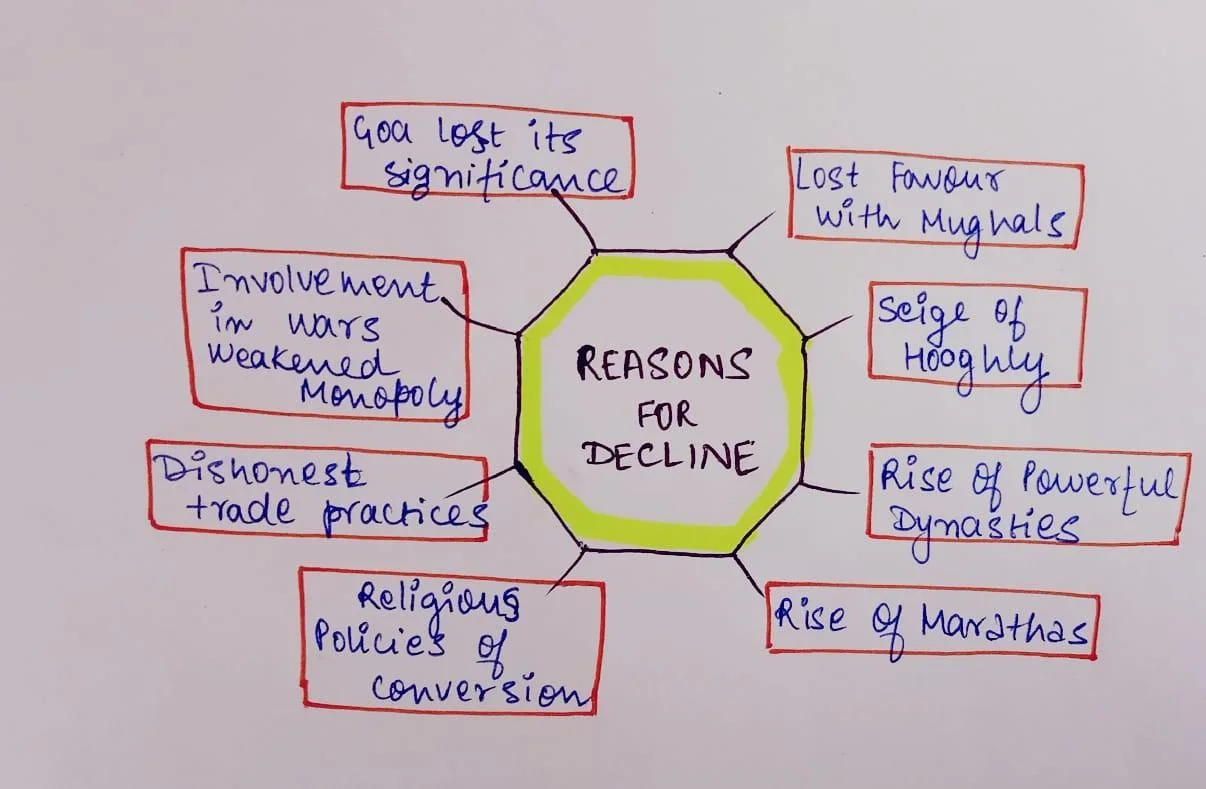
- Granting trading privileges to the English sparked conflict with the Portuguese, leading to a temporary truce.
- Despite frustrations and wavering Mughal policies, Hawkins left the court in 1611.
- Strained Relations with Mughals: In 1612, the English ship Dragon, led by Captain Best, defeated the Portuguese fleet, impressing
Jahangir.
- However, Portuguese piracy strained relations with Jahangir, resulting in his order for compensation to the Mughal government.
- Portuguese influence waned during Shah Jahan’s reign, dashing hopes of converting the royal family to Christianity, initially fostered by the Portuguese during Akbar and Jahangir’s welcoming reception.
- Capture of Hooghly: In late 1579, the Portuguese settled near Satgaon in Bengal, establishing a trading hub.
- They developed Hooghly as a new port, monopolizing salt production and imposing duties on tobacco.
- Slave Trade and Forced Conversion Irked the Mughals: They also engaged in a cruel slave trade, forcibly converting Hindu and Muslim children to Christianity.
- Siege of Hooghly: This led to a conflict with the Mughals, culminating in a siege of Hooghly in 1632. Shah Jahan ordered the Bengal governor to take action against the Portuguese.
- The siege resulted in a Portuguese retreat, with the Mughals suffering casualties and taking prisoners.
- The captives were given the choice of conversion or slavery. The persecution of Christians eventually subsided.
Other factors that led to their Decline
- Rise of powerful dynasties in Egypt, Persia, and North India, as well as the emergence of the Marathas as formidable neighbours.
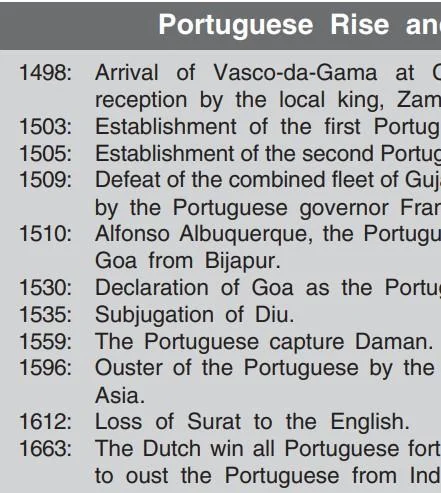
- Religious policies, especially Jesuit activities, led to political tensions.
- The policy of Christian conversion angered both Muslims and Hindus, and dishonest trade practices caused resentment.
- Declining Portugal’s Trade Monopoly: The Portuguese gained a reputation as sea pirates, earning animosity from small states and the Mughals.
- The union of Spain and Portugal in the late 16th century, and subsequent involvement in wars with England and Holland, weakened Portugal’s trade monopoly in India.
- Relative Competition: The Dutch and English, gaining knowledge of the sea route to India, posed fierce competition. With greater resources and overseas ambitions, they gradually overcame Portuguese resistance.
- Goa, though still under Portuguese control, lost its significance as a port. The Dutch took control of the spice trade, and Brazil replaced Goa as Portugal’s economic center. In 1683, the Marathas successfully invaded Goa after two naval assaults.
Significance of the Portuguese
Artillery and Warfare:
- Naval Power and Foreign Influence: The arrival of the Portuguese in India marked a significant shift towards naval power and foreign influence via sea routes.
- Portuguese ships were armed with cannons, giving them an advantage in trade negotiations through the threat or use of force. They disregarded established rules and aimed to dominate the Indian Ocean trade.
- Military innovation, during the 16th century, the Portuguese introduced new techniques in Malabar, including body armour, matchlock firearms, and ship-based artillery.
- They also introduced drilling techniques for infantry, which later became a key aspect of Indian armies. Portuguese ships were designed to withstand Atlantic gales, allowing them to carry heavier weapons.
- Ship Building:
- Their use of fortified prow and stern designs influenced Indian shipbuilding. The Portuguese excelled in organisation, establishing arsenals, dockyards, and a system of pilots and mapping.
- Art and Culture:
- Fusion of European and Indian Techniques: Despite the negative aspects of religious persecution, the Portuguese contributed to the arts in India, particularly in painting, carving, and sculpture.
- They played a role in introducing European art forms to India, including silversmith and goldsmith techniques.
- Goa became a centre for intricate metalwork, including filigree and jewel-embedded pieces.
- The art of the silversmith and goldsmith flourished at Goa, and the place became a centre of elaborate filigree work, fretted foliage work, and metalwork embedding jewels.
- Architecture: Churches such as The Basilica of Bom Jesus in Goa, built under Portuguese influence were characterized by ornate interiors with woodwork, sculpture, and occasionally painted ceilings while maintaining a generally simple architectural plan.
- Historical Research: The missionaries conducted extensive research into the history and culture of India. Fa Heras conducted an in-depth examination of the Indus Valley Civilization.
- Fusion of European and Indian Techniques: Despite the negative aspects of religious persecution, the Portuguese contributed to the arts in India, particularly in painting, carving, and sculpture.
- Contribution to Printing and Vernacular Language:
- The Portuguese introduced the printing press to India, leading to the printing of the Bible in Kannada and Malayalam languages.
- Agriculture:
- The Portuguese introduced various crops to India, including tobacco, as well as a variety of fruits and vegetables such as potatoes, okra, chilli, pineapple, sapota, and groundnuts.
| Views
The Portuguese entered India with the sword in one hand and the crucifix in the other; finding much gold, they laid aside the crucifix to fill their pockets, and not being able to hold them up with one hand, they were grown so heavy, they dropped the sword, too; being found in this posture by those who came after, they were easily overcome. —Alfonso de Souza, the Portuguese Governor in India (1542-45) |
Enroll now for UPSC Online Course
| Must Read | |
| Current Affairs | Editorial Analysis |
| Upsc Notes | Upsc Blogs |
| NCERT Notes | Free Main Answer Writing |
Conclusion
Within the Indian Subcontinent, the Portuguese established the Portuguese State of India, popularly referred to as Portuguese India. They were the first Europeans to arrive in India and the last to go. Vasco Da Gama was the first Portuguese to set foot in India in 1498. Nonetheless, it is believed that the Portuguese ruled India from 1505 till 1961. Their colonialism was more persistent than English colonialism, however, it had less of an impact outside of its colonies.
Sign up for the PWOnlyIAS Online Course by Physics Wallah and start your journey to IAS success today!
| Related Articles | |
| PORTUGUESE IN INDIA (1505-1961) | MUGHAL PERIOD (1526-40 and 1555-1857) |
| European Union (EU) | Three Different Stages of Colonialism |

 GS Foundation
GS Foundation Optional Course
Optional Course Combo Courses
Combo Courses Degree Program
Degree Program









